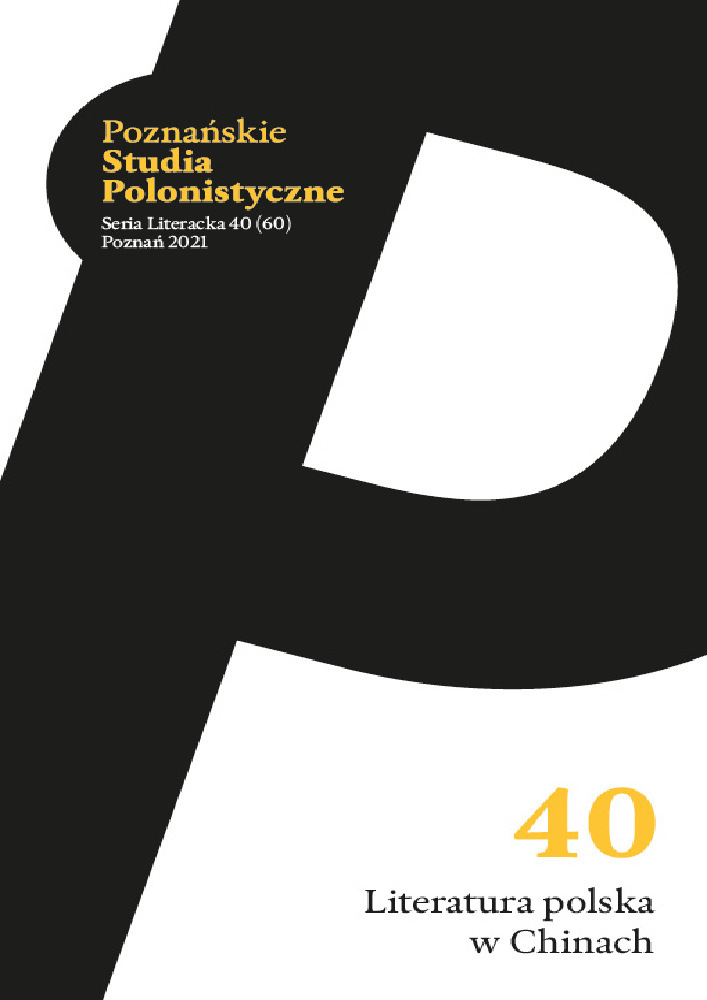Abstrakt
The article is an analysis of the description of the garden in Bruno Schulz’s The Cinnamon Shops (Sklepy cynamonowe) and its two translations into Chinese. Wei-Yun Lin-Górecka has translated Schulz’s prose from the original Polish, while Lu Yuan’s translation is primarily based on English versions of his work. The analysis employs methods drawn from cognitive poetics and some elements of cognitive theory of translation, especially Elżbieta Tabakowska’s ideas on imagery and translation equivalence. The study helped characterize a complex conceptual blend found in the description and trace structural changes caused by the translators’ specific decisions. The translations are characterized by a relatively high level of equivalence. The conceptual blends they comprise differ from the one created by Bruno Schulz mostly in terms of the described elements’ positions on the empathy scale, which are mainly dependent upon the translators’ manner of using the devices of animation and anthropomorphism.
Bibliografia
Boase-Beier Jean (2011), A Critical Introduction to Translation Studies, Continuum, London.
Brône Geert, Vandaele Jeroen, red. (2009), Cognitive Poetics: Goals, Gains and Gaps, De Gruyter Mouton, Berlin.
Crisp Peter (2003), Conceptual Metaphor and Its Expressions, w: Cognitive Poetics in Practice, red. Joanna Gavins, Gerard Steen, Routledge, London, s. 99-113.
Danaher David S. (2006), Poetyka kognitywna a literackość: analogia metaforyczna w „Annie Kareninie”, przeł. Małgorzata Majewska, „Przestrzenie Teorii”, nr 6, s. 277-298, https://doi.org/10.14746/pt.2006.6.16.
Fauconnier Gilles, Turner Mark (2019), Jak myślimy. Mieszaniny pojęciowe i ukryta złożoność umysłu, przeł. Izabela Michalska, Fundacja Augusta hr. Cieszkowskiego, Warszawa.
Fu Xiaowei, Wang Yi (2008), The Influence of Jewish Literature in China, w: The Jewish-Chinese Nexus. A Meeting of Civilizations, red. M. Avrum Ehrlich, Routledge, Abingdon–New York, s. 118-132.
Gavins Joanna, Steen Gerard, red. (2003), Cognitive Poetics in Practice, Routledge, London.
Iversen Margaret (2006), Im blinden Feld: Hopper und das Unheimliche, w: Orte des Unheimlichen: Die Faszination verborgenen Grauens in Literatur und bildender Kunst, red. Klaus Herding, Gerlinde Gehrig, Vandenhoeck & Ruprecht, Göttingen, s. 272-299.
Jakubów Zofia (2018), Kognitywna analiza opisu zmierzchu we fragmencie „Sklepów cynamonowych” Brunona Schulza, w: Orientaliści kognitywnie, red. Joanna Jurewicz, Elipsa, Warszawa, s. 67-78.
Jurewicz Joanna (2018), Wprowadzenie, w: Orientaliści kognitywnie, red. Joanna Jurewicz, Elipsa, Warszawa, s. 7-14.
Lakoff George, Johnson Mark (1988), Metafory w naszym życiu, przeł. Tomasz Krzeszówski, PIW, Warszawa.
Lakoff George, Johnson Mark (1999), Philosophy in the Flesh: The Embodied Mind and Its Challenge to Western Thought, Basic Books, New York.
Lin-Górecka Wei-Yun (2013), Transpacyficzna transcendencja. O tłumaczeniu Schulza na język chiński, „Schulz/Forum”, nr 2, s. 113-118.
Nie Liping (2020), Lu Yuan: gen ciyu jinxing bodou yu hezuo, wei jianli meihao zhixu nuli, „Xin Jingbao”, [dostęp: 8 września 2020], https://tinyurl.com/s8pcuhy8.
Rojo Ana, Ibarretxe-Antuñano Iraide (2013), Cognitive Linguistics and Translation Studies: Past, Present and Future, w: Cognitive Linguistics and Translation: Advances in Some Theoretical Models and Applications, red. Ana Rojo, Iraide Ibarretxe-Antuñano, De Gruyter Mouton, Berlin, s. 3-30.
Schulz Bruno (1989), Opowiadania. Wybór esejów i listów, red. Jerzy Jarzębski, Ossolineum, Wrocław.
Schulz Bruno (2016), Eyu Jie: Bulunuo Shuerci xiaoshuo quanji, przeł. Lin Weiyun, [dostęp: 4 września 2020], https://yuedu.163.com/book_reader/37bcd030ad1f43d188bb9e23ed62995e_4, Guilin.
Schulz Bruno (2017), Rouguise puzi ji qita gushi, przeł. Lu Yuan, Sichuan Renmin Chubanshe, [dostęp: 4 września 2020] https://yuedu.163.com/book_reader/b12c2506de8b4c8b92b5f17bf42daa50_4, Chengdu.
Słownik języka polskiego PWN (2020), Kożuch [hasło], [dostęp: 16 września 2020], https://tinyurl.com/49dxwuva.
Stockwell Peter (2006), Poetyka kognitywna. Wprowadzenie, red. Elżbieta Tabakowska, przeł. Anna Skucińska, Universitas, Kraków.
Tabakowska Elżbieta (2001), Językoznawstwo kognitywne a poetyka przekładu, przeł. Agnieszka Pokojska, Universitas, Kraków.
Wojda Dorota (2009), Bruno Schulz and the Magical Realism of Gabriel García Márquez in „One Hundred Years of Solitude”, w: (Un)masking Bruno Schulz: New Combinations, Further Fragmentations, Ultimate Reintegrations, red. Dieter De Bruyn, Kris Van Heuckelom, Rodopi, Amsterdam–New York, s. 173-193.
Wu Lan (2010), Bruno Schulz w Chinach, „Postscriptum Polonistyczne”, nr 2 (6), s. 253-260.
Yang Deyou (2011), Shuerci zuopin yishi, „Mingzuo Xinshang”, nr 6, s. 5-17.
Licencja
Autorzy
Autorzy tekstów przyjętych do publikacji w czasopiśmie „Poznańskie Studia Polonistyczne. Seria Literacka” są zobowiązani do wypełnienia, podpisania i odesłania na adres redakcji umowy o udzielenie nieodpłatnej licencji do utworów, z zobowiązaniem do udzielania sublicencji CC.
Zgodnie z umową, autorzy tekstów opublikowanych w czasopiśmie „Poznańskie Studia Polonistyczne. Seria Literacka” udzielają Uniwersytetowi im. Adama Mickiewicza w Poznaniu niewyłącznej i nieodpłatnej licencji oraz zezwalają na użycie sublicencji Creative Commons Attribution-NoDerivatives 4.0 International (CC BY-ND 4.0).
Autorzy zachowują prawa do dalszego, swobodnego rozporządzania utworem.
Użytkownicy
Zainteresowani użytkownicy internetu uprawnieni są do korzystania z utworów opublikowanych od 2016 roku w „Poznańskich Studiach Polonistycznych. Serii Literackiej” pod następującymi warunkami:
- uznanie autorstwa – obowiązek podania wraz z rozpowszechnionym utworem, informacji, o autorstwie, tytule, źródle (odnośniki do oryginalnego utworu, DOI) oraz samej licencji;
- bez tworzenia utworów zależnych – utwór musi być zachowany w oryginalnej postaci, nie można bez zgody twórcy rozpowszechniać np. tłumaczeń, opracowań.
Do wszystkich tekstów opublikowanych przed 2016 r. prawa autorskie są zastrzeżone.
Inne
Uniwersytet im. Adama Mickiewicza w Poznaniu zachowuje prawo do czasopisma jako całości (układ, forma graficzna, tytuł, projekt okładki, logo itp.).
